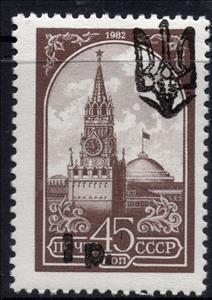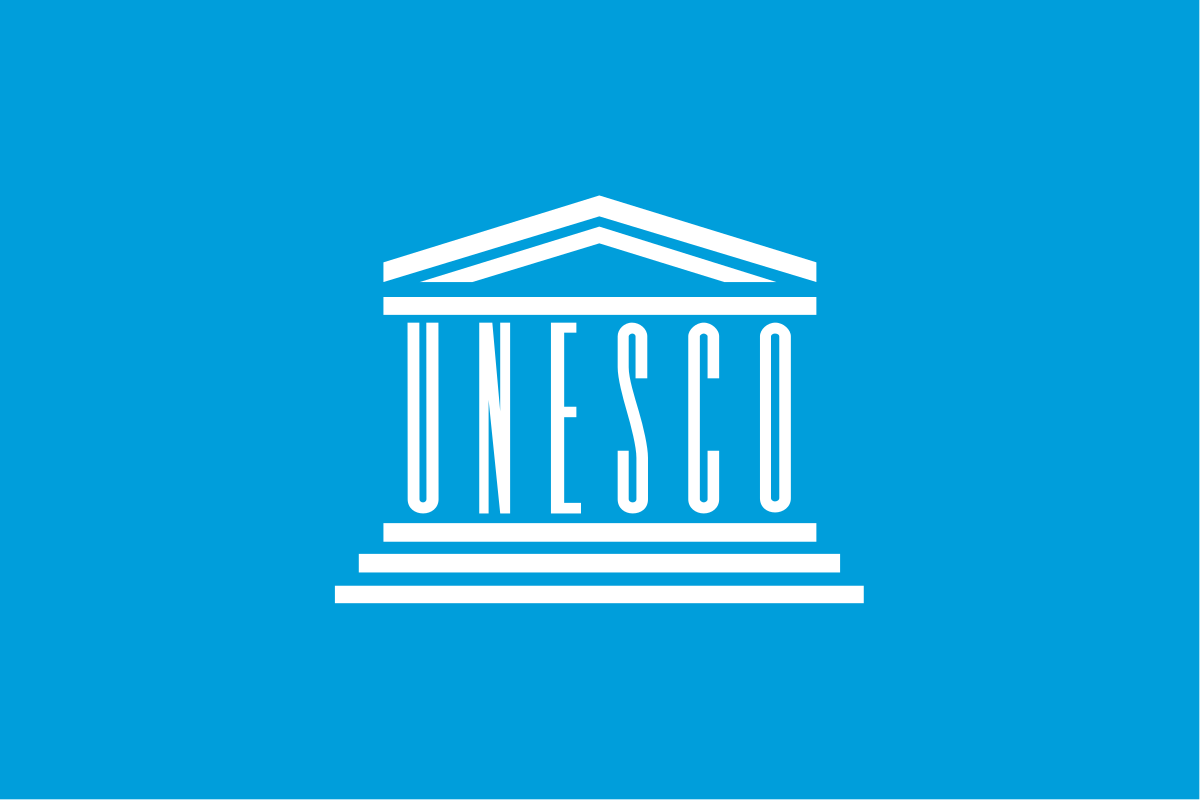Stamp: Melitopol 2nd Emergency issue (Cinderellas 1992)
Melitopol 2nd Emergency issue (Cinderellas 1992)
01 January (Cinderellas ) within release Ukraine goes into circulation Stamp Melitopol 2nd Emergency issue face value 100 Ukrainian kopiyka
| Stamp Melitopol 2nd Emergency issue in catalogues | |
|---|---|
| Colnect codes: | Col: UA-330 |
Stamp is vertical format.
Black Trident overprint on 45k USSR stamp issued in 1982Also in the issue Ukraine:
- Stamp - Overprint face value 4;
- Stamp - Bessarabia Emergency overprints face value 10;
- Stamp - 1st Poltava Emergency Issue face value 3;
- Stamp - 1st SUMY Emergency Issue face value 10;
- Stamp - Bessarabia Emergency overprints face value 10;
- Stamp - Vinnytsia Emergency overprint no. 1 face value 0.70;
- Stamp - Volyn Oblast overprint face value 15;
- Stamp - Bessarabia Emergency overprints face value 10;
- Stamp - 1st SUMY Emergency Issue face value 15;
- Stamp - Vinnytsia Emergency overprint no. 1 face value 1.50;
- Stamp - 1st Poltava Emergency Issue face value 15;
- Stamp - Bessarabia Emergency overprints face value 10;
- Stamp - 1st Poltava Emergency Issue face value 20;
- Stamp - 1st SUMY Emergency Issue face value 8;
- Stamp - Vinnytsia Emergency overprint no. 1 face value 1;
- Stamp - Vinnytsia Emergency overprint no. 1 face value 5;
- Stamp - 1st SUMY Emergency Issue face value 15;
- Stamp - Vinnytsia Emergency overprint no. 1 face value 3.60;
- Stamp - 1st SUMY Emergency Issue face value 35;
- Stamp - Vinnytsia Emergency overprint no. 2 face value 15;
- Stamp - 1st SUMY Emergency Issue face value 35;
- Stamp - 1st SUMY Emergency Issue face value 5;
- Stamp - 1st Poltava Emergency Issue face value 9;
- Stamp - Vinnytsia Emergency overprint no. 1 face value 0.50;
- Stamp - Vinnytsia Emergency overprint no. 2 face value 3;
- Stamp - Bessarabia Emergency overprints face value 10;
- Stamp - 1st Poltava Emergency Issue face value 70;
- Stamp - Bessarabia Emergency overprints face value 10;
- Stamp - 1st Poltava Emergency Issue face value 85;
- Stamp - Volyn Oblast overprint face value 15;
- Stamp - Volyn Oblast overprint face value 6;
- Stamp - 1st SUMY Emergency Issue face value 5;
- Stamp - Bessarabia Emergency Overprints face value 10;
- Stamp - Volyn Oblast overprint face value 6;
- Se-tenant - Kiev - Taxe percue overprint face value None;
- Stamp - 1st SUMY Emergency Issue face value 10;
- Stamp - Vinnytsia Emergency overprint no. 2 face value 20;
- Stamp - 1st Poltava Emergency Issue face value 3;
- Stamp - Melitopol 1st Emergency issue face value 100;
- Stamp - Melitopol 2nd Emergency issue face value 150;
- Stamp - Melitopol 3rd Emergency issue face value 100;
- Stamp - Melitopol 2nd Emergency issue face value 100;
- Stamp - Melitopol 2nd Emergency issue face value 50;
- Stamp - Melitopol 3rd Emergency issue face value 50;
- Stamp - Melitopol 3rd Emergency issue face value 100;
- Stamp - Melitopol 1st Emergency issue face value 50;
- Stamp - Melitopol 3rd Emergency issue face value 150;
- Stamp - Melitopol 3rd Emergency issue face value 150;
- Stamp - Melitopol 1st Emergency issue face value 100;
- Stamp - Melitopol 3rd Emergency issue face value 100;
- Stamp - Melitopol 2nd Emergency issue face value 50;
- Stamp - Melitopol 3rd Emergency issue face value 50;
- Stamp - Melitopol 3rd Emergency issue face value 100;
- Stamp - Melitopol 1st Emergency issue face value 150;
- Stamp - Melitopol 2nd Emergency issue face value 100;
- Stamp - Melitopol 1st Emergency issue face value 50;
- Stamp - Melitopol 1st Emergency issue face value 50;
- Stamp - Melitopol 2nd Emergency issue face value 100;
- Stamp - Melitopol 2nd Emergency issue face value 100;
- Stamp - Melitopol 3rd Emergency issue face value 150;
- Stamp - Melitopol 2nd Emergency issue face value 150;
- Stamp - Melitopol 1st Emergency issue face value 100;
- Stamp - Melitopol 3rd Emergency issue face value 50;
- Stamp - Melitopol 2nd Emergency issue face value 50;
- Stamp - Melitopol 1st Emergency issue face value 100;
- Stamp - Melitopol 1st Emergency issue face value 50;
- Stamp - Melitopol 2nd Emergency issue face value 50;
- Stamp - Melitopol 2nd Emergency issue face value 150;
- Stamp - Melitopol 1st Emergency issue face value 100;
- Stamp - Vinnytsia Emergency overprint no. 2 face value 70;
- Stamp - Bilhorod Dnistrovskyi face value 250;
- Stamp - Bilhorod Dnistrovskyi face value 500;
- Stamp - Bilhorod Dnistrovskyi face value 1,892;
- Stamp - Bilhorod Dnistrovskyi face value 2,522;
- Stamp - Coat of Arms face value 6;
Stamp Melitopol 2nd Emergency issue it reflects the thematic directions:
A building or edifice is a structure with a roof and walls standing more or less permanently in one place, such as a house or factory. Buildings come in a variety of sizes, shapes and functions, and have been adapted throughout history for a wide number of factors, from building materials available, to weather conditions, to land prices, ground conditions, specific uses and aesthetic reasons. Buildings serve several needs of society – primarily as shelter from weather, security, living space, privacy, to store belongings, and to comfortably live and work. A building as a shelter represents a physical division of the human habitat (a place of comfort and safety) and the outside (a place that at times may be harsh and harmful).
A flag is a piece of fabric (most often rectangular or quadrilateral) with a distinctive design that is used as a symbol, as a signaling device, or as decoration. The term flag is also used to refer to the graphic design employed, and flags have since evolved into a general tool for rudimentary signalling and identification, especially in environments where communication is similarly challenging (such as the maritime environment where semaphore is used). National flags are patriotic symbols with varied wide-ranging interpretations, often including strong military associations due to their original and ongoing military uses. Flags are also used in messaging, advertising, or for other decorative purposes. The study of flags is known as vexillology, from the Latin word vexillum, meaning flag or banner.
A symbol is a mark, sign, or word that indicates, signifies, or is understood as representing an idea, object, or relationship. Symbols allow people to go beyond what is known or seen by creating linkages between otherwise very different concepts and experiences. All communication (and data processing) is achieved through the use of symbols. Symbols take the form of words, sounds, gestures, ideas, or visual images and are used to convey other ideas and beliefs. For example, a red octagon is a common symbol for "STOP"; on maps, blue lines often represent rivers; and a red rose often symbolizes love and compassion. Numerals are symbols for numbers; letters of an alphabet may be symbols for certain phonemes; and personal names are symbols representing individuals.
The United Nations Educational, Scientific and Cultural Organization (UNESCO; pronounced /juːˈnɛskoʊ/) is a specialized agency of the United Nations (UN) with the aim of promoting world peace and security through international cooperation in education, arts, sciences and culture. It has 194 member states and 12 associate members,as well as partners in the non-governmental, intergovernmental and private sector. Headquartered in Paris, France, UNESCO has 53 regional field offices and 199 national commissions




